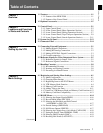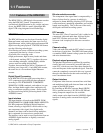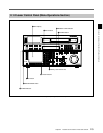
Chapter 1 Overview
Chapter 1 Overview 1-5
The following accessories can be used with the HDW-
F500.
BKDW-509 Parallel (50-pin) Interface Kit
A 50-pin parallel interfaces makes the HDW-F500
compatible with different broadcast station systems.
HKDV-501A HD-SD Converter Board
Allows you to output an NTSC/PAL component or
composite signal.
HKDV-502 HD Line Converter Board
• Allows you to convert an effective scanning line
number from 1035 to 1080 or from 1080 to 1035.
Note
This function is operative only when the frame
frequency of the VTR is set to 29.97Hz or 30Hz.
• Allows you to smooth the picture motion and
improve the vertical resolution during slow-motion
playback. Note that this function does not work
when this VTR is operated in PsF mode.
HKDV-503 HD Digital Video Controller
This allows you to remotely control the parameters for
video signals and image enhancement.
HKDV-506A SDTI Board
This board allows the input and output of special non-
degrading SDTI
1)
(270Mbps) signals.
HKDV-507/507D HD Pull Down Board
This board allows the output of 2-3 pull down HD
signal of 59.94i or 60i mode when this unit is operated
with the frame frequency of 23.98 or 24 Hz. The 2-3
pull down sequence is as follows.
Note
The 2-3 pull down sequence is guaranteed only when
this VTR is in normal play mode.
References
In addition to this Operation Manual, the following
manuals are available:
• Maintenance Manual Part 1
Provides information necessary for users to maintain
the VTR.
• Maintenance Manual Part 2 (sold separately)
Provides additional information to fully maintain the
HDW-F500. Contains details on electrical
adjustments, circuit diagrams, and other items.
1-2 Optional Accessories
..........................................................................................................................................................................................................
1) SDTI (Serial Data Transport Interface)
SDTI is defined as SMPTE-305M.
A(f1)
A(f1) A(f2) B(f1) B(f2) B(f1) C(f2) C(f1)D(f2) D(f1)D(f2)
A(f2) B(f1) B(f2) C(f1) C(f2) D(f1) D(f2)


















